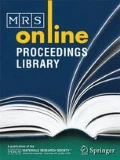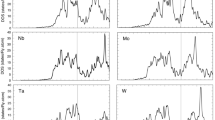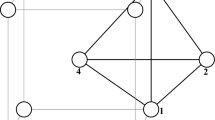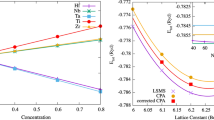Abstract
We have partially solved the ground state problem of binary alloys on the fee lattice with pair interactions up to the fourth nearest neighbor distance. Our results extend the study presented by Kanamori and Kakehashi [1], releasing the constraint they imposed on the nearest neighbor correlation. The solution we present increases the number of possible ground state structures by an order of magnitude with respect to previous results. We have applied both the polyhedron and the enumeration method. The latter proved more powerful when including interactions beyond the second nearest neighbor distance.
Similar content being viewed by others
References
J. Kanamori and Y. Kakehashi, J. Phys. (Paris) Colloq. 38, C7–274 (1977).
G. Ceder, A Derivation of the Ising Model for the Computation of Phase Diagrams, to be published in Computational Materials Science (1992).
C. Wolverton, G. Ceder, D. de Fontaine and H. Dreyssé, Phys. Rev. B 45, 13105 (1992).
J.M. Sanchez, F. Ducastelle, and D. Gratias, Physica A 128, 334 (1984).
J. Kanamori, Prog. Theor. Phys. 35, 16 (1966).
S. M. Allen and J.W. Cahn, Acta Metall. 20, 423 (1972).
J.M. Sanchez and D. de Fontaine, Structure and Bonding in Crystals (Academic, New York, 1981), Vol.II p. 117.
F. Ducastelle, Order and Phase Stability in Alloys, North Holland, New York (1991).
V. Chvétal, Linear Programming, W.H. Freeman and Company, New York (1983).
A more limited version of this approach was applied in L.G. Ferreira, S.H. Wei and A. Zunger, Supercomputer Applications 5, 34 (1991). They were only interested in the ground state structures for a given set of interactions and they only included about 32,000 structures (up to volume 15).
It could (and in fact does) happen that two different structures with the same volume have the same set of correlations. In this case we only keep one set of correlations to compute the ground states, but keep in mind that these two structures will be degenerated within the approximation used.
Acknowledgments
This work was sponsored in part by the National Science Foundation MRL Contract DMR90-22933. G.D.G. acknowledges the Rocca Fellowship under which part of this work was done. We thank Kenneth Clarkson for his help in solving the convex hull problem. The support of Steve Steiner in the computer programming is gratefully acknowledged.
Author information
Authors and Affiliations
Rights and permissions
About this article
Cite this article
Garbulsky, G.D., Tepesch, P.D. & Ceder, G. Ground State Analysis on the FCC Lattice with Four Pair Interactions. MRS Online Proceedings Library 291, 259–265 (1992). https://doi.org/10.1557/PROC-291-259
Published:
Issue Date:
DOI: https://doi.org/10.1557/PROC-291-259




